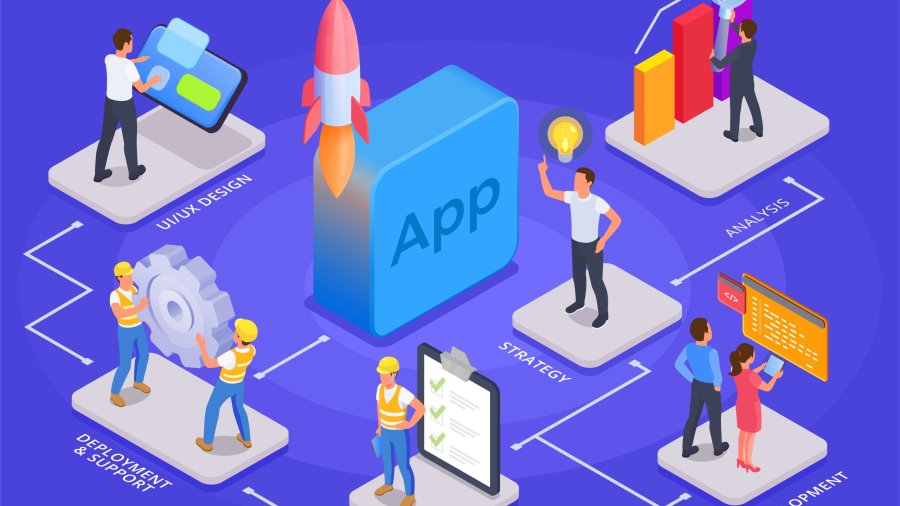The dream of building a Software as a Service (SaaS) product no longer requires years of coding experience or a team of developers. With the rise of powerful no-code SaaS tools, entrepreneurs and business owners can now build SaaS without coding and bring their ideas to market faster than ever before.
In 2025, the no-code movement has matured significantly, offering robust platforms that can handle everything from simple workflows to complex enterprise applications. Whether you’re a solopreneur with a groundbreaking idea or an established business looking to expand your digital offerings, these tools can help you launch your SaaS product without writing a single line of code.
Why Choose No-Code for Your SaaS Product?
Before diving into the best tools, let’s understand why no-code SaaS tools have become the go-to choice for modern entrepreneurs:
Speed to Market: Traditional SaaS development can take months or years. No-code platforms enable you to build and launch in weeks, providing a crucial first-mover advantage.
Cost-Effective: Hiring a development team can cost hundreds of thousands of dollars. No-code tools typically require only monthly subscriptions, making SaaS development accessible to bootstrapped entrepreneurs.
Iteration and Testing: When you build SaaS without coding, you can quickly modify features, test new ideas, and pivot based on user feedback without expensive development cycles.
Focus on Business Logic: Rather than wrestling with technical implementation, you can concentrate on solving customer problems and developing a sustainable business model.
Top No-Code Tools to Build Your SaaS Product in 2025
1. Bubble – The Powerhouse for Complex SaaS Applications
Bubble remains the gold standard among no-code SaaS tools for building sophisticated web applications. This platform offers the flexibility and power needed to create feature-rich SaaS products.
Key Features:
- Advanced database management with complex relationships
- Custom workflows and business logic
- User authentication and role-based permissions
- API integrations and custom API creation
- Responsive design capabilities
- Plugin marketplace for extended functionality
Best For: Complex SaaS applications requiring advanced features like multi-tenant architecture, detailed user management, and intricate business workflows.
Pricing: Free tier available, paid plans start at $29/month.
2. Adalo – Mobile-First SaaS Development
As mobile usage continues to dominate, Adalo has positioned itself as the leading platform to build SaaS without coding for mobile-first experiences.
Key Features:
- Native mobile app development
- Progressive Web App (PWA) capabilities
- Database management with relationships
- Push notifications
- In-app payments integration
- Custom actions and workflows
Best For: SaaS products that prioritize mobile experience or require native mobile applications alongside web platforms.
Pricing: Free tier with Adalo branding, paid plans from $50/month.
3. Glide – Rapid Prototyping and Launch
Glide excels at transforming spreadsheets into powerful SaaS applications, making it one of the fastest no-code SaaS tools for getting from idea to launch.
Key Features:
- Spreadsheet-to-app conversion
- Real-time data synchronization
- Custom forms and data collection
- User profiles and authentication
- Rich media support
- Team collaboration features
Best For: Data-driven SaaS applications, internal tools, and MVPs that need rapid deployment.
Pricing: Free tier available, pro plans start at $25/month per app.
4. Webflow – Design-Centric SaaS Solutions
Webflow combines powerful design capabilities with CMS functionality, making it ideal for content-heavy SaaS products or those requiring exceptional visual design.
Key Features:
- Advanced visual design tools
- Custom CMS and database
- E-commerce integration
- SEO optimization tools
- Custom code insertion when needed
- Hosting and CDN included
Best For: SaaS products focusing on content management, design tools, or marketing platforms where visual appeal is crucial.
Pricing: Free tier available, CMS plans start at $16/month.
5. Zapier – Automation-Focused SaaS Building
While primarily known as an automation tool, Zapier’s advanced features now allow users to build SaaS without coding by creating complex automated workflows and interfaces.
Key Features:
- Multi-step automation workflows
- Integration with 5000+ apps
- Custom webhooks and API calls
- Data storage and manipulation
- Conditional logic and branching
- Team collaboration and sharing
Best For: SaaS products centered around automation, data processing, or workflow optimization.
Pricing: Free tier with limitations, paid plans from $29.99/month.
6. Airtable – Database-Driven SaaS Solutions
Airtable bridges the gap between spreadsheets and databases, offering powerful no-code SaaS tools for building data-centric applications.
Key Features:
- Flexible database with multiple views
- Custom forms and interfaces
- Automation and workflow triggers
- API access for integrations
- Collaboration and permission management
- Rich field types and relationships
Best For: CRM systems, project management tools, inventory management, and any SaaS requiring complex data relationships.
Pricing: Free tier available, plus plans start at $12/month per user.
7. Notion – All-in-One Workspace SaaS
Notion has evolved into a platform where you can build SaaS without coding for productivity and collaboration applications.
Key Features:
- Flexible page and database system
- Custom templates and workflows
- Team collaboration tools
- API for external integrations
- Public page sharing
- Advanced permission settings
Best For: Productivity tools, knowledge management systems, and collaborative workspace applications.
Pricing: Free for personal use, team plans start at $10/month per user.
8. Retool – Internal Tool Specialist
Retool specializes in helping businesses build SaaS without coding for internal applications and admin panels.
Key Features:
- Drag-and-drop interface builder
- Database connections (SQL, NoSQL)
- Custom JavaScript when needed
- Advanced permissions and audit logs
- Mobile-responsive design
- Version control and collaboration
Best For: Internal dashboards, admin panels, and business intelligence tools.
Pricing: Free tier for up to 5 users, paid plans from $10/month per user.

Essential Features Every No-Code SaaS Should Include:
When using no-code SaaS tools to build your product, ensure you incorporate these crucial features:
User Authentication and Management
Implement secure user registration, login, and profile management. Most no-code platforms offer built-in authentication, but ensure it meets your security requirements.
Payment Processing
Integrate reliable payment gateways like Stripe or PayPal. Many no-code SaaS tools offer native integrations that handle subscriptions, billing, and payment processing automatically.
Database and Data Management
Design your data structure carefully from the beginning. Consider user data, application data, and analytics data. Ensure your chosen platform can handle your expected data volume and complexity.
API Integrations
Even when you build SaaS without coding, you’ll likely need to integrate with third-party services. Choose platforms that offer extensive API integration capabilities.
Analytics and Reporting
Build in analytics from day one to understand user behavior, track key metrics, and make data-driven decisions about your SaaS product’s development.
Mobile Responsiveness
Ensure your SaaS product works seamlessly across all devices. Most modern no-code SaaS tools provide responsive design options, but always test thoroughly.
Best Practices for No-Code SaaS Development

Start with an MVP
Begin with a Minimum Viable Product that solves your core problem. No-code SaaS tools make it easy to add features later, so focus on getting your essential functionality right first.
Plan Your Data Structure
Spend time designing your database schema before building. Changes to the data structure can be complex later, even with no-code platforms.
Focus on User Experience
Just because you’re using no-code SaaS tools doesn’t mean you should compromise on UX. Invest time in creating intuitive, user-friendly interfaces.
Test Thoroughly
Test your application across different devices, browsers, and user scenarios. No-code doesn’t mean no-testing.
Plan for Scale
Consider how your chosen platform handles increased users, data, and complexity. Some no-code SaaS tools have limitations that might require migration as you grow.
Security First
Implement proper security measures, including data encryption, secure authentication, and regular backups. Ensure your chosen platform meets industry security standards.
Overcoming Common No-Code Limitations

While no-code SaaS tools are powerful, they do have limitations. Here’s how to work around them:
Performance Optimization
Some no-code platforms can be slower than custom-coded solutions. Optimize by minimizing database queries, using efficient workflows, and choosing platforms with good performance records.
Customization Constraints
When standard features don’t meet your needs, look for platforms that allow custom code injection or consider hybrid approaches combining no-code and traditional development.
Vendor Lock-in
Choose platforms that offer data export options and API access to avoid being completely locked into one vendor’s ecosystem.
Complex Business Logic
For very complex business rules, you might need to combine multiple no-code tools or use platforms that support custom functions and advanced workflows.
The Future of No-Code SaaS Development
As we move through 2025, no-code SaaS tools continue to evolve rapidly. We’re seeing trends toward:
- AI-Powered Development: Platforms are incorporating AI to help with design, development, and optimization decisions.
- Better Integration Ecosystems: More seamless connections between different no-code tools and traditional software.
- Enhanced Performance: Continued improvements in speed and scalability of no-code platforms.
- Advanced Security Features: Better compliance tools and security measures built into no-code platforms.
My Honest Opinion
No-code SaaS tools in 2025 offer powerful, flexible, and reliable solutions for creating and launching successful SaaS products. Choose the platform best for your needs, such as Bubble for complex applications or Adalo for mobile-first solutions. Success requires understanding your market, solving problems, and building a sustainable business. Start small, test frequently, and iterate based on user feedback.
Recommended Reading:


Add a Comment